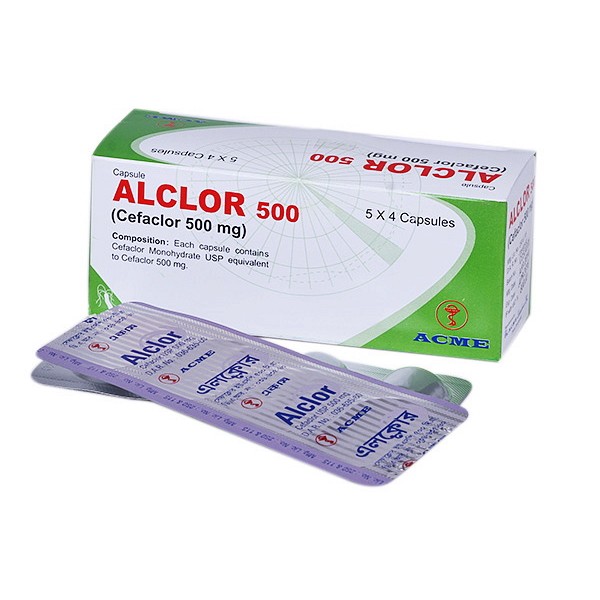
- Stock: In Stock
- Brand: Acme Laboratories Limited
- Product ID: Cefaclor Monohydrate
100% Secure Payment

This Item is for pre order
Alclor 500mg Capsule
DESCRIPTION
Cefaclor is a second generation Cephalosporin antibiotic which has stability against β-lactamase inactivation and possesses a broad spectrum of activity. Cefaclor is active against the following organisms in vitro: Aerobes, Gram-positive: Alpha and beta haemolytic Streptococci, Staphylococci; including coagulase- positive, coagulase-negative and penicillinase-producing strains, Streptococcus pneumoniae, Streptococcus pyogenes (Group A β-haemolytic Streptococci)and Staphylococci. Aerobes, Gram-negative: Moraxella catarrhalis, Branhamella catarrhalis, Haemophilus influenzae, (including ampicillinresistant strains), Escherichia coli, Proteus mirabilis, Klebsiella sp., Citobacter diversus and Neisseria gonorrhea. Anaerobes: Propionibacteria acnes, Bacteroides sp. (excluding Bacteroides fragilis), Peptococci and Peptostreptococcus sp.
COMPOSITION
Capsule Alclor 500: Each capsule contains Cefaclor monohydrate USP equivalent to Cefaclor 500 mg.
Alclor powder for 100 ml suspension: Each 5 ml reconstituted suspension contains Cefaclor monohydrate USP equivalent to Cefaclor 125 mg.
Alclor powder for 15 ml paediatric drops: Each 1.25 ml reconstituted paediatric drops contains Cefaclor monohydrate USP equivalent to Cefaclor 125 mg.
INDICATION
Alclor (Cefaclor) is indicated for the treatment of the following infections due to susceptible micro-organisms: Respiratory tract infections including pneumonia, bronchitis, exacerbation of chronic bronchitis, pharyngitis, tonsillitis and as part of the management of sinusitis; Otitis media, Otitis media with effusion (OME); Skin and soft tissue infections; Urinary tract infections including pyelonephritis and cystitis; It is effective in both acute and chronic urinary tract infections.
DOSAGE AND ADMINISTRATION
Alclor (Cefaclor) is administered orally. Adults: The usual adult dosage is 250 mg every eight hours. For more severe infections or those caused by less susceptible organisms, doses may be doubled.
Alclor may be administered in the presence of impaired renal function. Under such conditions, dosage is usually unchanged. Patients undergoing haemodialysis: Haemodialysis shortens serum halflife by 25-30%. In patients undergoing regular haemodialysis, a loading dose of 250mg-1g administered prior to dialysis and a therapeutic dose of 250-500mg every six to eight hours maintained during interdialytic periods is recommended. The elderly: As for adults.
Children: The usual recommended daily dosage for children is 20mg/kg/day in divided doses, every eight hours, as indicated. For bronchitis and pneumonia, the dosage is 20mg/kg/day in divided doses, administered 3 times daily. For otitis media and pharyngitis, the total daily dosage may be divided and administered every 12 hours. Safety and efficacy have not been established for use in infants aged less than one month.
Alclor powder for Paediatric drops (125 mg/5 ml) In more serious infections, otitis media, sinusitis and infections caused by less susceptible organisms, 40mg/kg/day in divided doses is recommended, up to a daily maximum of 1g. In the treatment of beta-haemolytic streptococcal infections, therapy should be continued for at least 10 days.
CONTRA-INDICATIONS
Alclor is contraindicated to the patients who are hypersensitive to cephalosporin class of antibiotics.
PRECAUTION
If super infection occurs during therapy, appropriate measures should be taken. If an allergic reaction to Cefaclor occurs, the drug should be discontinued and then be treated with appropriate agents.
SIDE EFFECT
diarrhoea (rarely antibiotic-associated colitis), nausea and vomiting, abdominal discomfort, headache; allergic reactions including rashes, pruritus, urticaria, serum sickness-like reactions with rashes, fever and arthralgia, and anaphylaxis; Stevens-Johnson syndrome, toxic epidermal necrolysis reported; disturbances in liver enzymes, transient hepatitis and cholestatic jaundice; other side-effects reported include eosinophilia and blood disorders (including thrombocytopenia, leucopenia, agranulocytosis, aplastic anaemia and hemolytic anemia); reversible interstitial nephritis, hyperactivity, nervousness, sleep disturbances, hallucinations, confusion, hypertonia, and dizziness.
DRUG INTERACTION
The nephrotoxicity of amino-glycoside antibiotics such as gentamicin and tobramicin may be enhanced by any Cephalosporin. Therefore, one should be cautious in concomitant use of these categories of drugs.
USE IN PREGNANCY AND LACTATION
Pregnancy: Not known to be harmful Breast-feeding: Present in milk in low concentration, but appropriate to use.
OVER DOSAGE
Symptoms of nausea, vomiting, epigastric distress and diarrhoea would be anticipated. Treatment: Unless 5 times the normal total daily dose has been ingested, gastrointestinal decontamination will not be necessary. General management may consist of supportive therapy.
SUPPLY
Capsule: Each box contains 5 x 4 capsules in Alu-Alu Blister Strip.
Powder for Suspension: Bottle containing dry powder to reconstitute 100 ml suspension and a measuring cup.
Powder for Paediatric drops: Bottle containing dry powder to reconstitute 15 ml paediatric drops with a Measuring Cup and a dropper.















%20Pvt.%20Ltd./Movicol-Oral-Powder-190x190.jpg)




